Johann Sebastian Bach was leader of the court orchestra and organist in Weimar from 1708 until 1717, when he moved on to Köthen, and his sons Wilhelm Friedemann and Carl Philipp Emanuel were born here; it was perhaps his first chance to have a full professional orchestra to work with. Hummel was Kapellmeister a hundred years later, from 1819 to 1837, and he was followed in turn by Listz, from 1848 to 1859, who made Weimar into a major musical centre; Liszt lived here again for much of the time from 1869 until his death in 1886.
As well as these musical attractions for me, Weimar has been home to the writers Goethe, Schiller, Herder and Wieland, and to the philosopher Nietzsche. Also of interest to me – although with no musical connections – the Bauhaus design movement was founded here in 1919. As was the ill-fated 'Weimar Republic', the attempt to re-establish German democracy after the First World War. An important stop on my Grand Tour, then, and also my base for visiting Bach's birthplace at Eisenach... / more |
Jakobskirche
Weimar was the first place on the Tour where I'd been aware of autumn leaves. I walked to the Jakobskirche and spent some time enjoying the unfamiliar sunshine and the autumn colours in the churchyard, where the great painter Lucas Cranach the Elder is buried, with Goethe's wife Christiane buried nearby; Goethe and Christiane Vulpius were finally married in the Jakobskirche in 1806, after scandalously living together for 18 years...
• Click for photos and more |
 |
Jakobskirche Tower
After a pleasant half-hour in the churchyard I climbed the stairs to the highest level of the tower. The church is being restored, and is full of scaffolding. The final climb is up a steep ladder with a handrail, but all is well at the top. I peered out of the tiny windows for some good views in each direction; the sharp point of the Herderkirche not far away to the south. Then into the body of the church on the way down to photograph the tall, tiered interior...
• Click for photos and more |
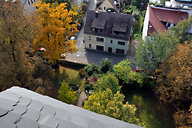 |
Herderkirche
The Stadtkirche St Peter und Paul is widely known as the Herderkirche, in memory of the German philosopher and writer Johann Gottfried Herder, who preached here over a period of some 30 years towards the end of his life. Being a Sunday the church was closed to visitors until the afternoon; I intended to return later to look inside – in particular to see the altar painting, almost certainly by Lucas Cranach the Younger in honour of his father...
• Click for photos and more |
 |
Musicians in Weimar
Of the three important composers with Weimar connections, only Franz Liszt is remembered well. His summerhouse in Marienstrasse is now the Liszt Museum, and he is also commemorated in the Franz Liszt School of Music. But all that remains of the house in which JS Bach lived is a wall with a plaque, next to the well-known Hotel Elephant. Hummel has his bust on a pedestal at the back of the Theatre, and is buried in the Historiche-Friedhof...
• Click for photos and more |
 |
Goethe and Schiller
Many of the visitors to Weimar are on the Goethe trail. For me he held no strong musical connections, although Beethoven and Schubert both set some of his texts. Beethoven also wrote the overture for Goethe's tragedy Egmont, a work which he greatly admired. The other big literary figure in Weimar is Goethe's friend Schiller. Again, the main musical link is Beethoven, who used Schiller's An die Freude as the basis for the choral finale of his ninth symphony...
• Click for photos and more |
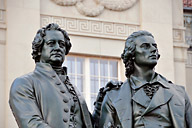 |
Lucas Cranach the Elder
The artist Lucas Cranach the Elder is well remembered in Weimar, but in fact only moved here in the last year of his life at the age of 80. He lived in what is now the brightly-painted Cranachhaus in the Markt, which was owned by his son-in-law. He is said to have started work here on his final painting, for the altar of the the Herderkirche, which was probably completed by his son Lucas Cranach the Younger. He was buried in the churchyard of the Jakobskirche...
• Click for photos and more |
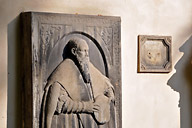 |
Markt
The market square is surrounded by a hotch-potch of buildings. Tallest is the town hall, built in 1841 and featuring a tower with a set of Meissen porcelain bells, which were chiming delightfully as I arrived. Opposite is the decorative green and white gable of the Stadthaus, now housing the Tourist Information office. Attached to it is the brightly-coloured Cranach House, built in 1549 for the son-in-law of Lucas Cranach the Elder, and on the south side of the Markt is the famous Hotel Elephant...
• Click for photos and more |
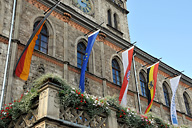 |
Platz der Demokratie
Dominating the large, cobbled Platz der Demokratie is the equestrian statue of Grand Duke Carl Augustus. On the south side of the square is the Fürstenhaus, now the main building of the Franz Liszt School of Music, where Goethe was received when he arrived in Weimar to work for the court. To its left, on the east side of the square, is the Grünes Schloss, which now contains the Herzogin-Anna-Amalia-Bibliotek, one of the most important collections of German literature in the world...
• Click for photos and more |
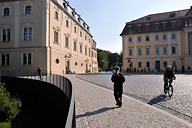 |
Residenz
While the sun was still shining I walked around the Schloss, at the north-eastern side of the town centre, on the edge of the Park an der Ilm, for some photos of the outside. The weather was too good for me to go inside, although I felt bad about it because I know there are some rare paintings by Lucas Cranach on show, including one of Martin Luther in his disguise as Junker Jörg while he was in hiding at the Wartburg in Eisenstadt.
• Click for photos and more |
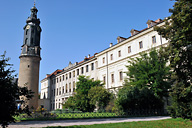 |
In the City
There are many attractive buildings and scenes and courtyards in Weimar, and a sunny Sunday brought out the colours and shapes. I was keen to photograph the Bauhaus-Universtät-Weimar, which was originally the Hocheschule für Architektur und Bauwesen where Walter Gropius established the Bauhaus design school in 1919, and where it stayed until it was forced to close and move to Dessau in 1925.
• Click for photos and more |
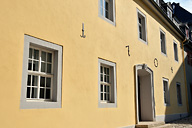 |
With several 'centres' – Goethe Platz (where all the buses meet), Theaterplatz, the Markt – and a gentle curve to some of the streets, I found Weimar a tricky place to navigate around. I got confused a couple of times; you think you know which way you're walking, then find you've turned through 90 degrees. Unusually for me, I couldn't instinctively follow my nose. It's quite cold, but it is the end of September. Weimar is the first place I've seen the beginning of autumn colours; I was suddenly aware of them on the walk down from the station on the first morning. |
|
|